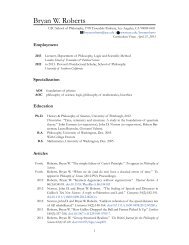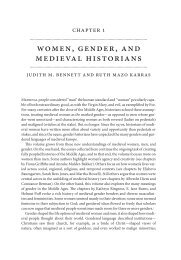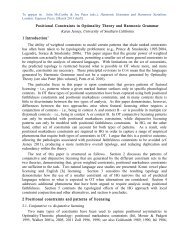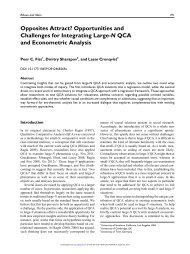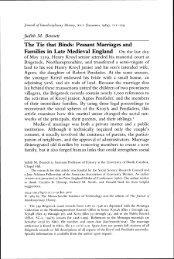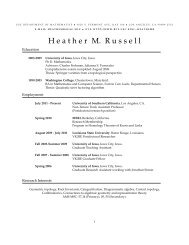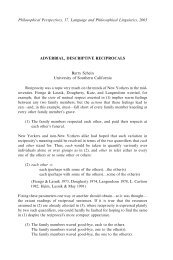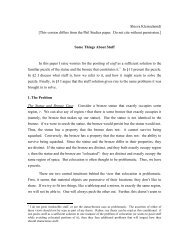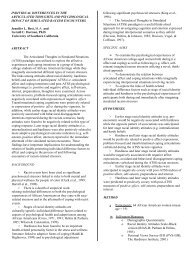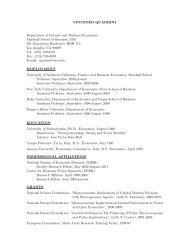The Racial Resegregation of Los Angeles County, 1940-2000
The Racial Resegregation of Los Angeles County, 1940-2000
The Racial Resegregation of Los Angeles County, 1940-2000
You also want an ePaper? Increase the reach of your titles
YUMPU automatically turns print PDFs into web optimized ePapers that Google loves.
Chart 4b: WHITE SETTLERS<br />
Probability that Whites w ill have Black, Hispanic, or Asian Neighbors<br />
in <strong>Los</strong> <strong>Angeles</strong> <strong>County</strong>, <strong>1940</strong>-<strong>2000</strong><br />
0.30<br />
0.25<br />
0.20<br />
0.15<br />
0.10<br />
0.05<br />
0.00<br />
<strong>1940</strong> 1950 1960 1970 1980 1990 <strong>2000</strong><br />
Whites w ith Hispanics 0.02 0.04 0.07 0.14 0.18 0.22 0.25<br />
Whites w ith Asians 0.01 0.01 0.01 0.02 0.07 0.1 0.14<br />
Whites w ith Blacks 0.01 0.02 0.02 0.02 0.04 0.05 0.05<br />
Whites w ith Hispanics<br />
Whites w ith Asians<br />
Whites w ith Blacks<br />
Chart 4b, “Probability that Whites will have Black, Hispanic, or Asian Neighbors<br />
in <strong>Los</strong> <strong>Angeles</strong> <strong>County</strong>, <strong>1940</strong>-<strong>2000</strong>,” looks at the White residential experience from the other direction as that<br />
shown in 4a. <strong>The</strong> Exposure Index is “asymmetric,” which means that we can see the segregation relation from<br />
two different perspectives for each pair <strong>of</strong> racial groups. Since the groups are all very different in size and<br />
location, these figures are not simple the inverse, but reveal the less obvious conditions <strong>of</strong> segregation that are<br />
a function <strong>of</strong> location. Thus, for example, looking back at Chart 4a, we see that Blacks had a 45% chance <strong>of</strong><br />
having White neighbors in <strong>1940</strong>, but here in Chart 4b we see that Whites in that same year had only a 1%<br />
chance <strong>of</strong> having a Black neighbor. This asymmetry can easily be explained by the fact that Blacks were<br />
vastly outnumbered in <strong>1940</strong>, and because most Black neighborhoods had significant White populations as well<br />
(which is no longer the case: Whites have almost completely removed themselves from Black neighborhoods).<br />
<strong>The</strong> hard fact is that this severe level <strong>of</strong> segregation has not changed significantly in 60 years <strong>of</strong> struggles<br />
against the White-Black divide. White families in <strong>Los</strong> <strong>Angeles</strong> <strong>County</strong> in <strong>2000</strong> still had only a 5% chance <strong>of</strong><br />
sharing their neighborhood with African American families.<br />
Whites are significantly more likely to have Hispanic neighbors, 25% in <strong>2000</strong> compared with 14% in 1970.<br />
But again, this figure is easy to explain by rapid increase in the Hispanic population and the steady decrease <strong>of</strong><br />
the White population. <strong>The</strong> Hispanic population has grown around many clusters <strong>of</strong> settlement in the <strong>County</strong>,<br />
and so the “edges” between Hispanic and White areas have grown in length, making increasing “exposure”<br />
more likely. To put this figure in perspective, we must again refer back to Chart 4a: Hispanics are less likely<br />
to have Whites as neighbors (18%), and this figure has been steadily declining.<br />
Whites are only in the year <strong>2000</strong> significantly likely to have Asian neighbors (14%), but again, Chart 4a<br />
shows that as Asians grow in population size, they are less likely to have White neighbors (down to 23% in<br />
<strong>2000</strong> from 49% in 1980).<br />
Race Contours <strong>2000</strong> –<strong>Resegregation</strong> <strong>of</strong> <strong>Los</strong> <strong>Angeles</strong> <strong>County</strong>, <strong>1940</strong>-<strong>2000</strong> 14



